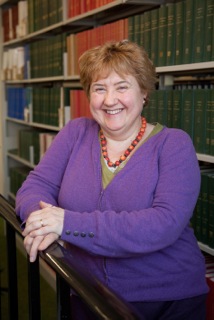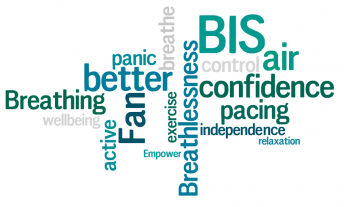A randomized controlled trial published today in BMC Medicine reports that the multidisciplinary Breathlessness Intervention Service (BIS) is effective in helping patients with advanced cancer cope with breathlessness. In this guest post, Sara Booth, co-author on the trial and founder of BIS, explains the research.
 Breathlessness (also called dyspnea) is becoming recognized as one of the most important symptoms that patients with advanced disease experience – whether their condition is malignant or non-malignant.
Breathlessness (also called dyspnea) is becoming recognized as one of the most important symptoms that patients with advanced disease experience – whether their condition is malignant or non-malignant.
Chronic breathlessness was neglected for many years; detection rates were low, with little research carried out, probably because clinicians did not know what to do if they diagnosed it. Happily, that situation is now changing with important statements on the subject from the American Thoracic Society (2012) and the American College of Chest Physicians, as well as advice on management included in NICE guidance for many conditions and the GOLD guidelines for COPD.
Our paper published today in BMC Medicine is a Phase III randomized controlled trial (RCT) – part of a number of studies that followed the MRC Evaluation of Complex Interventions guidelines to develop a research-based Breathlessness Service for those with chronic intractable breathlessness, i.e. breathlessness that persists when the underlying disease has been maximally treated.
The breathlessness associated with chronic illness is very different from the sensation you feel when you run up a hill in health, or swim, or do something athletic or joyful. It has no happy associations; it is not exhilarating but frightening, distressing and very disabling. The drive to breathe is a primitive instinct for us all, and not being able to breathe properly is associated with tremendous anxiety.
The foundations of BIS
I became interested in managing breathlessness in the early 1990s, when I first entered palliative medicine from anaesthesia. I was stimulated to investigate further because I was asked to write a paper on the subject and found lots of assertions about how it should be managed, but very little evidence. Professor Abe Guz (who sadly died recently) and Julius Comroe were pioneers in trying to improve the lot of people with breathlessness; Comroe was writing a perceptive definition of the symptom when he said that:
“[breathlessness] involved both the perception of the sensation by the patient and his reaction to it…”
Here, he anticipated the findings of neuroimaging, recognizing that the brain is central to the generation of the sensation of breathlessness. I was introduced to Professor Guz and Lewis Adams and we carried out one of the first clinical trials in hospice patients, testing oxygen and air for the relief of breathlessness – hypothesizing that the correction of hyperemia would reduce the sensation of breathlessness.
We gave patients oxygen or air from disguised cylinders thinking that the air would be a placebo. In fact, to our surprise, we found that both oxygen and air reduced the sensation of breathlessness, but that oxygen was not any better than air. The draught of cool air across the face, in the areas subserved by the second and third branches of the trigeminal nerve, produced the reduction in breathlessness, by some mechanism – possibly via the brain stem respiratory center.
This finding (and other work, particularly a study by Schwartzstein in healthy volunteers) encouraged me to start using the fan in patients with breathlessness. Then I continued to work with Lewis Adams, validating the Shuttle Walking Test, an exercise test as an outcome measure for breathlessness in hospice patients.
It seemed counterintuitive to many people to perform an exercise test in patients in a hospice; there was none of the evidence demonstrating that exercise is good for people with cancer or other advanced disease that now exists. I found that patients enjoyed the exercise and that it was useful for them to exercise in front of their relatives, who saw that they became breathless, but then sat down and became able to breathe more easily within minutes. This encouraged them to help their breathless family member to do enjoyable activities.
The natural instinct for carers of those with illness who get breathless when they move around is to tell them to rest. In fact, this is very bad for most people as their muscles become weak, change structure and use their fuel less effectively. The breathless person then becomes breathless at an even lower level of activity.
I moved to Addenbrooke’s Hospital in Cambridge in 1998 and started the series of research projects that culminates in today’s publication. In the first study I worked with Professor Chis Todd (then at Cambridge), to try and understand the experience of breathless patients with cancer and chronic obstructive pulmonary disease (COPD), and that of their carers. This demonstrated how frightening, disabling, distressing and isolating breathlessness itself was, with far reaching consequences on the lives of the family carers, as well as the patient.
Because of my other experience with the fan, and with the fact that patients liked to exercise, I started a breathlessness service with charitable money, giving patients access to a skilled physiotherapist (first in post was Petrea Fagan) and medical support.
The Breathlessness Intervention Service: early days
 We started to collaborate with Irene Higginson of King’s College London and took on Morag Farquhar, both of whom have worked on these projects ever since and developed other services and breathlessness research programs. We asked patients what they thought about the team, i.e. seeing a physiotherapist or doctor in their own home, and overwhelmingly the findings on that occasion were the same as we find today; they felt that they could manage their breathlessness themselves and were less frightened by it, they liked the emphasis the team gave to what was working in their lives, rather than dwelling on what had been lost, they were encouraged and did more because of the individualized exercise plans, and the hand-held fan gave them confidence that they could do something themselves to manage their own breathlessness. The support for carers and the education about breathlessness were also greatly valued.
We started to collaborate with Irene Higginson of King’s College London and took on Morag Farquhar, both of whom have worked on these projects ever since and developed other services and breathlessness research programs. We asked patients what they thought about the team, i.e. seeing a physiotherapist or doctor in their own home, and overwhelmingly the findings on that occasion were the same as we find today; they felt that they could manage their breathlessness themselves and were less frightened by it, they liked the emphasis the team gave to what was working in their lives, rather than dwelling on what had been lost, they were encouraged and did more because of the individualized exercise plans, and the hand-held fan gave them confidence that they could do something themselves to manage their own breathlessness. The support for carers and the education about breathlessness were also greatly valued.
Overwhelmingly, patients and their carers were pleased that the care team was called a breathlessness service because they thought the name legitimized their symptom in the same way that pain has always been understood as serious by the public.
We then set up a phase II trial to test the idea of recruiting patients to the trial. We could not set up a placebo, so patients were recruited to receive either the Service straight away or after 4 weeks, and we would test them at the mid-point, when some had received the Service and some were just about to.
We found that this recruitment method worked and we then proceeded to the phase III trial, which is published today. I cannot stress enough how important it was to do this phase II work, because we overcame difficulties with outcome measures and recruitment problems.
This research has taught me so much about the lives of people living with breathlessness and there are now a number of breathlessness services (in slightly different models) across the world. It shows that breathlessness can be helped, and it is the duty of all clinicians to make sure they listen to their patients, who may be telling them how troubling their breathlessness is, and then to make efforts to help them, not simply leave the patients with a diagnosis.
Comments